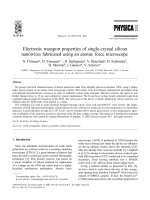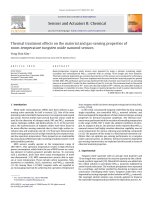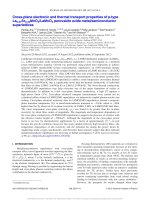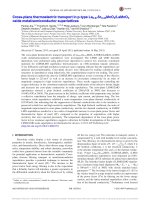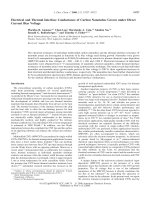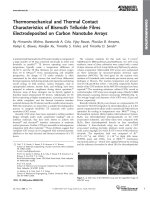cross plane electronic and thermal transport properties of p type la0.67sr0.33mno3 lamno3 perovskite oxide metal semiconductor superlattices
Bạn đang xem bản rút gọn của tài liệu. Xem và tải ngay bản đầy đủ của tài liệu tại đây (3.15 MB, 8 trang )
Cross-plane electronic and thermal transport properties of p-type
La
0.67
Sr
0.33
MnO
3
/LaMnO
3
perovskite oxide metal/semiconductor
superlattices
Pankaj Jha,
1,2
Timothy D. Sands,
1,2,3,a)
Laura Cassels,
4
Philip Jackson,
5
Tela Favaloro,
5
Benjamin Kirk,
6
Joshua Zide,
4
Xianfan Xu,
6
and Ali Shakouri
1,2
1
School of Electrical and Computer Engineering, Purdue University, West Lafayette, Indiana 47907, USA
2
Birck Nanotechnology Center, Purdue University, West Lafayette, Indiana 47907, USA
3
School of Materials Engineering, Purdue University, West Lafayette, Indiana 47907, USA
4
Material Science and Engineering Department, University of Delaware, Newark, Delaware 19716, USA
5
Electrical Engineering Department, University of California, Santa Cruz, California 95064, USA
6
School of Mechanical Engineering and Birck Nanotechnology Center, Purdue University, West Lafayette,
Indiana 47907, USA
(Received 26 March 2012; accepted 24 August 2012; published online 26 September 2012)
Lanthanum strontium manganate (La
0.67
Sr
0.33
MnO
3
, i.e., LSMO)/lanthanum manganate (LaMnO
3
,
i.e., LMO) perovskite oxide metal/semiconductor superlattices were investigated as a potential
p-type thermoelectric material. Growth was performed using pulsed laser deposition to achieve
epitaxial LSMO (metal)/LMO (p-type semiconductor) superlattices on (100)-strontium titanate
(STO) substrates. The mag nitude of the in-plane Seebeck coefficient of LSMO thin films (<20 lV/K)
is consistent with metallic behavior, while LMO thin films were p-type with a room temperature
Seebeck coefficient of 140 lV/K. Thermal conductivity measurements via the photo-acoustic (PA)
technique showed that LSMO/LMO superlattices exhibit a room temperature cross-plane thermal
conductivity (0.89 W/mÁK) that is significantly lower than the thermal conductivity of individual
thin films of either LSMO (1.60 W/mÁK) or LMO (1.29 W/mÁK). The lower thermal conductivity
of LSMO/LMO superlattices may help overcome one of the major limitations of oxides as
thermoelectrics. In addition to a low cro ss-plane thermal conductivity, a high ZT requires a
high power factor (S
2
r). Cross-plane electrical transport measurements were carried out on
cylindrical pillars etche d in LSMO/LMO superlattices via inductively coupled plasma reactive ion
etching. Cross-plane electrical resistivity data for LSMO/LMO superlattices showed a magnetic
phase transition temperature (T
P
) or metal-semiconductor transition at $330 K, which is $80 K
higher than the T
P
observed for in-plane resistivity of LSMO, LMO, or LSMO/LMO thin films.
The room temperature cross-plane resistivity (q
c
) was found to be greater than the in-plane
resistivity by about three orders of m agnitude. The magnitude and temperature dependence of
the cross-plane conductivity of LSMO/LMO superlattices suggests the presence of a barrier with
the effective barrier height of $300 meV. Although the magnitude of the cross-plane power
factor is too low for thermoelectric applications by a factor of approximately 10
À4
—in part
because the growth conditions chosen for t his study yielded relatively high resistivity films—the
temperature dependence of the resistivity and the potential for tuning the power factor by
engineering strain, oxygen stoichiometry, and electronic band structure suggest that these epitaxial
metal/semiconductor superlattices are deserving of further investigation.
V
C
2012 American Institute
of Physics.[ />I. INTRODUCTION
Metal/semiconductor superlattices with cross-plane
transport offer a novel approach towards improving the ther-
moelectric materials figure of merit (ZT).
1,2
ZT, is given by
ZT ¼
S
2
r
ðj
e
þj
l
Þ
T, where S is the Seebeck coefficient, r is the
electrical conductivity, j is the thermal conductivity, and T
is the absolute temperature (K). The enhancement in (S
2
r)
through energy filtering is possible by engineering the barrier
height and cross-plane phonon scattering reduces the lattice
contribution to the thermal conductivity.
Existing thermoelectric (TE) materials are restricted in
their maximum operating temperature because of low melt-
ing or decomposition temperatures, scarce or toxic compo-
nent elements such as Bi, Te, Co, and Pb, or low ZT values
at temperatures greater than about 700 K. The thermal and
chemical stability of oxides at elevated operating tempera-
tures, the possibility of finding compositions with naturally
abundant and nontoxic constituents, and the low production
costs for bulk materials make oxides an attractive candidate
material for TE devices. Oxides have been previously
avoided for TE devices due to strongly ionic behavior and
narrow conducting bandwidths from weak orbital overlap
leading to localized electrons with low carrier mobilities.
3
However, the prospects for oxides changed when large
a)
0021-8979/2012/112(6)/063714/8/$30.00
V
C
2012 American Institute of Physics112, 063714-1
JOURNAL OF APPLIED PHYSICS 112, 063714 (2012)
Downloaded 02 Oct 2012 to 128.46.221.182. Redistribution subject to AIP license or copyright; see />power factors were observed by Terasaki et al. in the mag-
netic layered cobalt oxide material, Na
x
Co
2
O
4
.
4
The power
factor is comparable to that of Bi
2
Te
3
, but the mobility is
one order of magnitude lower, suggesting that a low mobility
conductor can also be an efficient thermoe lectric material.
Later, Wang et al. proposed that the large power factor in
Na
x
Co
2
O
4
is related to its antiferromagnetic behavior at
room temperature. The spin states are free to transfer about
the crystal and these “moving spins” (spin entropy) carry
energy that contributes to the power factor.
5
This unexpect-
edly large power factor in layered cobalt oxide materials
inspired research in p-type materials such as Ca
3
Co
4
O
9
and
Bi
2
Sr
3
Co
2
O
y
. However, ZT was found to be low due to high
room temperature thermal conductivities (4–5 W/mÁK).
6,7
It
was later concluded that metal-oxide ZT values exceeding 2
would be difficult to achieve because of their large j
T
values
(3–10 W/mÁK) compared with those of the heavy metallic
alloys (0.5–2 W/mÁK).
8
While these investigations have
attracted a great deal of research, no major breakthroughs in
oxide TE materials have yet emerged.
The present study was designed to investigate p-type per-
ovskite oxide metal/semiconductor superlattices as a potential
prototype materials system for thermoelectric power genera-
tion. Lanthanum strontium manganate La
0.67
Sr
0.33
MnO
3
(LSMO) was i nvestigate d as a metal and l anthanum m angan ate,
LaMnO
3
(LMO), as a p-type semiconductor for metal/semicon-
ductor superlattices grown on strontium titanate SrTiO
3
(STO)
substrates. La
0.67
Sr
0.33
MnO
3
isbasedonLaMnO
3
(Mn
3þ
,
t
3
2g
e
1
g
) as the parent compound, where La
3þ
is partially
replaced by Sr
2þ
, which forces a partial change of M n
3þ
to
Mn
4þ
with no e
g
electron (t
3
2g
e
0
g
), resulting in a mixed Mn va-
lence accompanied by hole doping. The hole may hop fro m a
Mn
4þ
iontoaMn
3þ
ion only if the localized spins are parallel;
the hopping action between adjacent Mn ions is dominated by
the double-exchange mechanism through an oxygen ion. The
double exch ange tran sport mechanism is responsible for the fer-
romagnetic and conductive ground state for Sr
2þ
doped manga-
nates.
9,10
LSMO is half-metallic, w here one spin band is partly
occupied at the Fermi level and the other has a nearly zero den-
sity of states across the Fermi level.
11
A strontium (Sr) concen-
tration of x ¼ 0.33 shows ferromagnetic metallic behavior with
a metal work function (A
m
)of5.2eV.
12
The parent manganese compound LaMnO
3
is antiferro-
magnetic and insulating in its ground state with ion vacancies
of La
3þ
,Mn
3þ
,andO
2À
, which allow doping on all lattice
sites. LMO undergoes a structural transformation at T $ 523 K
from the Jahn-Teller distorted orthorhombic phase to a high-
temperature cubic semiconducting phase.
13
The electrical
properties are tunable by varying the oxygen stoichiometry to
achieve a p-type semiconductor that conducts by cation transi-
tions. The cation vacancies are responsible for the ferromag-
netic as well as the semiconducting behavior.
14
LMO has a
band gap of E
g
¼ 1.1 eV and electron affinity of 4.4 eV.
15
The LSMO (metal)/LMO (p-type semiconductor) super-
lattice is expected to have a Schottky barrier height in the
range that would be consistent with effective energy filtering
at high temperatures (600–900 K), thereby enhancing the See-
beck coefficient.
16
Based on the relation A
B
¼ E
g
þ v
s
À A
m
,
a Schottky barrier (A
B
)heightof$300 meV at 300 K is
expected. LSMO and LMO have closely matched lattice
parameters that allow the growth of epitaxial superlattices
with sharp interfaces. If the thermal conductivity can be sup-
pressed while enhancing the power factor (increased square of
the Seebeck coefficient due to energy filtering that more than
offsets the decrease in cross-plane electrical conductivity),
then enhanced ZT would be expected.
17
In this paper, the growth of LSMO/LMO superlattices
along with characterization of the materials and their elec-
tronic and thermal properties is reported. Growth conditions
that yield relatively low carrier concentrations have been cho-
sen in order to better isolate relevant physical phenomena in
cross-plane thermal and electrical transport by suppressing the
effects of parasitic electrical series resistance and the elec-
tronic contributions to the thermal conductivity. The results
suggest that the barrier height of the superlattice composition
investigated is too high for thermoelectric applications near
room temperature but possibly suitable for elevated tempera-
ture operation. On the other hand, the reduction of lattice
thermal conductivity by interfaces is found to be effective,
even at room temperature. Finally, the results suggest poten-
tial for applications in magnetoresistive sensors at tempera-
tures of 300 K and higher.
18–20
II. EXPERIMENT
Epitaxial LSMO film growth on (100)-oriented cubic STO
substrates was ach ieved us ing pulsed l aser deposition ( PLD)
with a 248 nm KrF excimer laser and a pulse width of 25 ns. A
laserfluenceof1.3J/cm
2
and a pulse frequency of 5 Hz were
used to ablate the sintered LSMO target. The deposition was
performed at a constant substrate temperature of 740
C, meas-
ured using an i nfrared pyrometer. PLD growth was performed
to achieve metallic epitaxial thin films of LSMO on STO using
a background O
2
pressure of 50 6 2 mTorr, which yielded
p-type semiconducting LMO. The target was polished prior to
each growth to ensure even film g rowthandtoavoidanylarge
particulates breaking off from the roughened target surface due
to laser thermal shock or heating of the subsurface before sur-
face vaporization. The L SMO growth r ate w as 0. 13 A
˚
/pulse,
with typical film thickness ranging from 300 nm to 400 nm.
X-ray diffraction (XRD) 2-theta-omega scans confirmed h001i-
textured LSMO films on STO substrates without any additional
peaks from impurity phases. The rocking curve full-width-at-
half-maximum intensity (FWHM) was found to be 0.012
,
suggesting an epitaxial film of high crystalline quality. XRD
asymmetric 110 Phi scans of LSMO on STO show all four
90
-separated film peaks are well aligned with the substrate
peaks, which confirmed highly aligned grains and in-plane
epitaxy.
LMO thin-film growth optimization to achieve p-type
semiconducting behavior on (100)-STO substrates was also
performed using PLD. The laser fluence was maintained at
1.3 J/cm
2
with a pulse frequency of 5 Hz. Variations in oxy-
gen pressure over the range of 40 to 65 mTorr had no impact
on the epitaxial growth of the thin films as evaluated by
XRD 2-theta-omega scans and Phi scans. In an oxygen pres-
sure window of 45–55 mTorr, a semi-transparent semicon-
ducting thin film of LMO was achieved. The evaporated
063714-2 Jha et al. J. Appl. Phys. 112, 063714 (2012)
Downloaded 02 Oct 2012 to 128.46.221.182. Redistribution subject to AIP license or copyright; see />target species reacted with the oxygen flow at a pressure main-
tained at 50 6 2 mTorr inside the chamber and a substrate
temperature of 740
C to achieve the LMO films with p-type
semiconducting behavior. The LMO growth rate was approxi-
mately $0.13 A
˚
/pulse. XRD 2-theta-omega scans confirm
c-axis aligned LMO films on STO substrates, and rocking
curves of LMO/STO show a small FWHM (0.028
), indicat-
ing that the film was of high crystal quality. LMO XRD
asymmetric 110 Phi scans confirmed highly aligned grains
and in-plane epitaxy.
Finally, p-type LSMO/LMO superlattices were grown
on (100)-STO substrates (Fig. 1) using the same growth con-
ditions. XRD 2-theta-omega scans indicate 002 film peaks in
the vicinity of the STO 002 peak, and the rocking curves
(LSMO FWHM was 0.027
and LMO FWHM was 0.102
)
of an LSMO/LMO superlattice were consistent with the
anticipated epitaxial relationship (Fig. 2(a)). Asymmetric
110 Phi scans of LSMO/LMO on STO show all four films
peaks separated by 90
, confirming in-plane epitaxy for all
layers of the superlattice.
In order to determine the degree of relaxation and strain
in the superlattice layers, reciprocal space mapping (RSM) of
the oxide superlattices was performed. A 110 asymmetric
RSM of an LSMO/LMO superlattice is shown in Figure 2(b).
In the RSM map, a small degree of spread (low FWHM) and
highly intense peaks confirm high-quality pseudomorphic
LSMO/LMO superlattice growth on STO substrates. Cross-
sectional transmission electron microscopy (TEM) images of
the superlattice were taken using an FEI Titan 80–300 operat-
ing at 300 kV, revealing the presence of an epitaxial layered
structure of high crystalline quality with sharp interfaces and
no obvious signs of interlayer diffusion (Fig. 3).
To perform temperature-dependent cross-plane electri-
cal measurements of LSMO/LMO superlattices, cylindrical
pillar structures (900 nm height and 300 lm diameter) were
fabricated using optically sensitive resist (AZ-9260) as a
mask for inductively coupled plasma reactive ion etching
(ICP-RIE) (Fig. 4). The optimal etching conditions were
40:10 sccm of Cl
2
:Ar, a chamber pre ssure of 0.7 Pa, an RF
forward power of 800 W, and a capacitive bias of 350 W.
The top and bottom contact metallization consisted of three
layers, Ti (10 nm)/Pt (40 nm)/Au (500 nm).
III. RESULTS AND DISCUSSION
A. LSMO and LMO thin films
The LSMO and LMO thin films were characterized using
Hall effect, four-probe temperature-dep endent resistivity (TDR),
and in-plane Seebeck measuremen t techniques. Hall effect char-
acterization of a 400 nm-thick epitaxial LSMO film on STO
showed a room temperature resistivity of 0.32 XÁcm and a hole
carrier concentration o f 1.38 Â 10
20
cm
À3
. I n-plane four-probe
TDR (Fig. 5(a) ) measu rements of an LSMO film sh owed a m ag-
netic phase transition temperature (T
P
)orCurietemperature
(T
c
) at 260 K, accompanied by a metal-semiconductor phase
transition, frequently referred to as a metal-insulator transition,
which is typically attributed to changes of the spin states,
charges, and orbital degrees of freedom .
21
The low te mperature
ferromagnetic metal to high temperature paramagnetic metal
transition causes an increase in conductivity. The transport
above the phase transition temperature is governed by the
FIG. 1. Schematic of metallic LSMO (8 nm)/semiconducting LMO (8 nm)
superlattice (LSMO/LMO)
60
structure.
FIG. 2. (a) XRD 2-theta-omega scan of an LSMO/LMO superlattice on a
STO (100) substrate confirming c-axis epitaxial behavior with LSMO
FWHM (0.027
) and LMO FWHM (0.102
) and (b) 110 RSM of a micron-
thick LSMO/LMO superlattice. The LSMO and LMO peaks have a small
degree of spread and show a consistent in-plane lattice parameter, confirm-
ing the pseudomorphic epitaxial growth of the superlattice film.
063714-3 Jha et al. J. Appl. Phys. 112, 063714 (2012)
Downloaded 02 Oct 2012 to 128.46.221.182. Redistribution subject to AIP license or copyright; see />polaron mechanism
22
yielding a temperature dependence
that can be described by a thermal activation energy (E
A
)of
162 6 8 meV, which was extracted using Arrhenius fitting of
the temperature dependent conductivity.
23,24
The in-plane
Seebeck measurement of LSMO showed a Seebeck coeffi-
cient with a magnitude less than 20 lV/K, consistent with
metallic behavior (Fig. 6(a)).
25
Hall effect characte rization of a 400 nm epitaxial LMO thin
film on STO revealed a room temperature resistivity of 10.4
XÁcm and a hole carrier concentration of 6.86 Â 10
18
cm
À3
.
Four-probe in-plane TDR of p-type LMO thin films showed a
T
P
at 240 K and semiconducting behavior above the phase tran-
sition with a thermal activation energy (E
A
)of1666 8meV
(Fig. 5(b) ). The in-plane Seebeck measurement (Fig. 6(b)) con-
firmed that the LMO films were p-typ e with a room temperature
Seebeck coefficient of 140 6 3 lV/K.
Epitaxial LSMO and LMO thin films were also character-
ized using magnetoresistance (MR) measurements. Magneto-
resistance is given by DR/R
H
¼ (R
H
À R
0
)/R
H
, where R
0
is the
resistance at H ¼ 0TandR
H
is measured at 0.2 T. The LSMO
in-plane TDR shows a T
P
at 260 K and a magnetic field transi-
tion (T
PB
) at 248 K, while the p-type LMO thin films show
aT
P
at 240 K and a T
PB
at 220 K (Figs. 5(a) and 5(b)).
However, the maximum MR was found to be at temperatures
below the T
P
and T
PB
temperatures; LSMO shows an MR
ratio of $16% at 210 K and the LMO MR ratio is $52% at
200 K, consistent with previous studies of perovskite thin
films with magnetic ions on the “B” site.
18–21,26
B. Thermal conductivity of LSMO/LMO superlattices
Thermal conductivity measurements of LSMO and LMO
thin films, as well as p-type LSMO/LMO superlattices, are
essential to evaluate potential thermoelectric applications. The
room temperature thermal conductivity of thin films and
superlattices were measured using the photo-acoustic (PA)
technique.
27
The sample was coated with 80 nm of titanium
deposited by e-beam evaporation using an Inficon deposition
controller to monitor Ti deposition thickness. Each sample
and the reference STO bare substrates were coated with Ti
simultaneously to achieve the same thickness and tolerance.
The sample was heated by the modulated laser beam to gener-
ate an acoustic signal. A condenser microphone that was built
FIG. 3. (a) Low-magnification cross-sectional bright field TEM images of an
LSMO (8 nm)/LMO (8 nm) superlattice and (b) high-resolution cross-section
TEM confirming epitaxial layer contrast of LSMO/LMO superlattices on
a STO (100) substrate were taken using FEI Titan operating at 300 kV. The
contrast in (a) along the normal to the growth surface is due to threading
dislocations.
FIG. 4. (a) Top view SEM images of anisotropically etched LSMO/LMO
superlattices with pillar heights of 1 lm and the schematic of final structure
of LSMO/LMO superlattices for I-V cross-plane measurement. (b) Side
view of final structure and (c) top view of final structure.
063714-4 Jha et al. J. Appl. Phys. 112, 063714 (2012)
Downloaded 02 Oct 2012 to 128.46.221.182. Redistribution subject to AIP license or copyright; see />into the PA cell was used to sense the acoustic signal and
transmit to a lock-in amplifier that measured the amplitude
and phase shift of the pressure signal. The measured signal
was then related to thermal properties of the sample using a
heat conduction model.
27
A detailed discussion of the PA
measurement technique is available elsewhere.
27,28
The meas-
ured cross-plane room temperature thermal conductivities of epi-
taxial thin films of LSMO and L MO are 1.60 6 0.075 W/mÁK
and 1.29 6 0.025 W/mÁK, respectively. Moreover, the cross-
plane thermal conductivity of p-type LSMO/LMO superlatti-
ces was found to be 0.89 6 0.21 W/mÁK, which is lower than
the reported value for bulk oxides, composite materials, or
heavy metal alloys. These results indicate that cross-plane
phonon scattering reduces the lattice contribution to the
thermal conductivity. The experimental amplitude measure-
ments as a function of the modulation frequency are shown
for LSMO (Fig. 7(a)), LMO (Fig. 7(b)),andanLSMO/LMO
superlattice (Fig. 7(c)). The Wiedemann-Franz law (j
e
¼ L
o
rT)
was used to estimate the electronic contribution (j
e
), where
L
o
¼ 2. 44 Â 10
À8
WXK
À2
. The lattice contribution to the total
thermal conductivity (j
l
) was determined using (j
l
¼ j
T
À j
e
).
The electronic contribution to the measured thermal conductiv-
ity was found to be negligible. The reduction in thermal con-
ductivity using p-type perovskite LSMO/LMO superlattices
suggests that coherent interfaces with nanoscale periods may
allow reduction of the lattice thermal conductivity in perovskite
oxides to levels that are required for high ZT thermoelectric
materials.
C. Cross-plane electronic transport in LSMO/LMO
superlattices
The in-plane temperature dependent resistivity of epi-
taxial LSMO/LMO superlattices showed a magnetic phase
transition temperature (T
P
) of 250 K (Fig. 8(a)) and an
extracted thermal activation energy (E
A
) of 101 6 5 meV
(Fig. 9). The cross-plane I-V measurement was performed for
the p-type LSMO/LMO superlattices as a function of tempera-
ture (100–600 K). The extracted cross-plane temperature-
dependent resistivity with magnetic phase transition (T
P
)
or Curie temperature (T
c
) at 330 K is shown in Figure 8(b).
The apparent T
P
was shifted to $330 K for cross-plane trans-
port through LSMO/LMO superlattices, $80 K higher than
the T
P
observed in in-plane measurements of LSMO, LMO
or LSMO/LMO thin films. Note, however, that the room
temperature cross-plane resistivity (q
c
) was increased by
three orders of magnitude compared to the in-plane resistiv-
ity. A similar q
c
enhancement was reported by Kimura et al.
with a cross-plane peak shifted downward to 100 K from
the in-plane peak at 270 K in a single crystal layered manga-
nate La
2-2x
Sr
1þ2x
Mn
2
O
7
(x ¼ 0.3).
29–31
Distortion of the
LMO octahedron (i.e., MnO
6
) and any alteration of the
Mn
4þ
/Mn
3þ
ratio, which can be modified by changes in oxy-
gen concentration, have a strong influence on transport prop-
erties. Also, tensile strain is responsible for a reduction in T
P
based on Jahn-Teller distortion theory.
32,33
We conclude that
FIG. 5. (a) Temperature-dependent in-plane resistivity of LSMO and (b)
temperature-dependent in-plane resistivity of LMO with and without a mag-
netic field applied in a direction normal to the film surface.
FIG. 6. (a) In-plane Seebeck measurement of LSMO shows Seebeck coeffi-
cient consistent with metallic behavior with a magnitude of less than 20 lV/K
and (b) in-plane Seebeck measurement of LMO validating p-type behavior
with a room temperature Seebeck coefficient of 140 6 3 lV/K.
063714-5 Jha et al. J. Appl. Phys. 112, 063714 (2012)
Downloaded 02 Oct 2012 to 128.46.221.182. Redistribution subject to AIP license or copyright; see />an increase in the compressive strain of LMO in the superlat-
tice structure enhanced the T
P
in the superlattices. This con-
clusion is supported by an increase in the superlattice LMO
FWHM to 0.102
, which is higher than the individual LMO
thin film FWHM (0.028
).
34,35
The cro ss-plane enhancement
in T
P
around room temperature may be promising for low-
magnetic-field magneto-resistive devices, spintronics, field
sensors, and magnetoresistive random access memory
(MRAM).
24,36
The extracted cross-plane conductivity of the superlat-
tice structure may suggest a contribu tion from thermionic
behavior above the phase transition temperature. The effec-
tive barrier height of 300 6 15 meV was extracted from the
cross-plane temperature-dependent electrical conductivity
data from LSMO/LMO superlattices assuming, for simplicity,
that the activated process(es) indicated by the temperature de-
pendence was entirely due to thermionic emission over bar-
riers at interfaces (Fig. 10). The extracted experimental barrier
height is consistent with the expected LSMO/LMO Schottky
FIG. 7. Photo-acoustic (PA) experimental amplitude measurement as a func-
tion of the modulation frequency for (a) LSMO sample, (b) LMO sample,
and (c) LSMO/LMO superlattice.
FIG. 8. (a) Measured in-plane resistivity and (b) extracted cross-plane resis-
tivity of p-type LSMO/LMO superlattice using temperature dependent I-V
measurement. The magnetic transition peak is shifted to T $ 330 K in cross-
plane transport through LSMO/LMO superlattices, $80 K higher than the
peak observed in in-plane resistivity in LSMO, LMO, or LSMO/LMO thin
films.
FIG. 9. The in-plane LSMO/LMO superlattices electrical conductivity fit-
ting plot to extract the effective thermal activation energy of 101 6 5 meV.
063714-6 Jha et al. J. Appl. Phys. 112, 063714 (2012)
Downloaded 02 Oct 2012 to 128.46.221.182. Redistribution subject to AIP license or copyright; see />barrier (A
B
) height of $300 meV at 300 K, which may be
responsible in part for a lower than expected cross-plane elec-
trical conductivity at 300 K. That the barrier height is too high
for optimal room temperature operation is also supported by a
measurement of the cross-plane Seebeck coefficient using a
thermal imaging technique.
37
The measured value was
1520 6 53 lV/K. Combining the cross-plane measurements of
the LSMO/LMO superlattices at 300 K yields a ZT less than
1 Â 10
À4
.ThislowZT is primarily a result of the growth con-
ditions (50 mTorr at 740
C) chosen for this study. Those con-
ditions yielded films with in-plane resistivities that are more
than two orders of magnitude higher than the resistivities
obtained at higher oxygen partial pressures during growth.
38
The high resistivities helped to suppress electrical and thermal
parasitics in cross-plane transport measurements, thereby sim-
plifying the interpretation of magnetotransport and lattice
thermal conductivity measurements. Further measurements at
higher temperatures and with lower resistivity heterostructures
grown at higher oxygen partial pressures will be necessary to
fully evaluate the potential of this oxide superlattice approach.
IV. CONCLUSIONS
Cross-plane transport in LSMO/LMO superlattices has
been presented as a potential route to a p-type thermoelectric
material. Epitaxial thin-film metallic LSMO and p-type LMO
with a room temperature Seebeck coefficient of 140 lV/K
were deposited by PLD. The growth parameters of p-type
LSMO and LMO were used to obtain high-quality epitaxial,
micron-thick LSMO/LMO superlattices, as confirmed by XRD
and cross-sectional TEM characterization. The measured
cross-plane resistivities of micron-thick LSMO/LMO superlat-
tices show an enhancement of the apparent magnetic phase
transition temperature, to T
P
$ 330 K, $80 K h igher t han e ither
LSMO thin films (T
P
$ 260 K), LMO thin films (T
P
$ 240 K),
or in-plane-measured LSMO/LMO su perlattices (T
P
$ 250 K).
The cross-plane enhancement in T
P
and the room temperature
cross-plane r esistivity increase by three orders of magnitude
may be promising for low-magnetic field magneto-resistive
devices and MRAM device applications. The room tempera-
ture cross-p lane thermal conductivity demonstrated in the
p-type LSMO/LMO superlattices was 0.89 W/mÁK, lower than
the cross-plane thermal conductivities of the individual thin-
film counterparts (LSMO and LMO). This reduction in lat-
tice thermal conductivity may help to further improve ZT in
oxide thermoelectrics. Finally, the temperature dependence
of the cross-plane electrical resistivity combined with the
high value of the cross-plane Seebeck coefficient (1520 lV/K
at 300 K) indicate that the barrier height at the LSMO/LMO
interface is too high for efficient thermoelectric operation at
300 K. Modification of the barrier height and doping levels for
a specific operating temperature range will be necessary to
fully evaluate the potential of this approach for thermoelectric
devices.
ACKNOWLEDGMENTS
The authors are thankful to Polina Burmistrova for TEM
imaging. The authors also like to thank Jeremy Schroeder
and Zhixi Bian for their helpful discussions. The authors
would like to acknowledge the support by the DARPA Nano-
structured Materials for Power program.
1
A. Shakouri and J. E. Bowers, “Heterostructure integrated thermionic
coolers,” Appl. Phys. Lett. 71(9), 1234 (1997).
2
G. D. Mahan and L. M. Woods, “Multilayer thermionic refrigeration,”
Phys. Rev. Lett. 80(18), 4016 (1998).
3
T. M. Tritt and M. A. Subramanian, "Thermoelectric materials, phenomena,
and applications: A bird’s eye view,” MRS Bull. 31(3), 188 (2006).
4
I. Terasaki, Y. Sasago, and K. Uchinokura, "Large thermoelectric power in
NaCo
2
O
4
single crystals," Phys. Rev. B 56(20), R12685 (1997).
5
Y. Y. Wang, N. S. Rogado, R. J. Cava, and N. P. Ong, “Spin entropy as
the likely source of enhanced thermopower in Na
x
Co
2
O
4
,” Nature
423(6938), 425 (2003).
6
I. Terasaki, “Transport properties and electronic states of the thermoelec-
tric oxide NaCo
2
O
4
,” Physica B 328(1–2), 63 (2003).
7
I.Terasaki,H.Tanaka,A.Satake,S.Okada,andT.Fujii,“Out-of-planether-
mal conductivity o f th e layered thermoelectric oxide Bi
2-x
Pb
x
Sr
2
Co
2
O
y
,”
Phys. Rev. B 70(21), 214106 (2004).
8
H. Ohta, S. Kim, Y. Mune, T. Mizoguchi, K. Nomura, S. Ohta, T. Nomura,
Y. Nakanishi, Y. Ikuhara, M. Hirano, H. Hosono, and K. Koumoto, “Giant
thermoelectric Seebeck coefficient of two-dimensional electron gas in
SrTiO
3
,” Nature Mater. 6(2), 129 (2007).
9
A. M. Haghiri-Gosnet and J. P. Renard, “CMR manganites: Physics, thin
films and devices,” J. Phys. D: Appl. Phys. 36(8), R127 (2003).
10
C. Zener, “Interaction between the d-shells in the transition metals. 2. Fer-
romagnetic compounds of manganese with perovskite structure,” Phys.
Rev. 82(3), 403 (1951).
11
G. Banach, R. Tyer, and W. M. Temmerman, “Study of half-metallicity in
LSMO,” J. Magn. Magn. Mater. 272, 1963 (2004).
12
A. Urushibara, Y. Morit omo, T. A rima, A. Asami tsu, G. Kido, and Y . Toku ra,
“Insulator-metal transition and giant magnetoresistance in La
1-x
Sr
x
MnO
3
,”
Phys. Rev. B 51(20), 14103 (1995).
13
C. Aruta, M. Angeloni, G. Balestrino, N. G. Boggio, P. G. Medaglia,
A. Tebano, B. Davidson, M. Baldini, D. Di Castro, P. Postorino, P. Dore,
A. Sidorenko, G. Allodi, and R. De Renzi, “Preparation and characteriza-
tion of LaMnO
3
thin films grown by pulsed laser deposition,” J. Appl.
Phys. 100(2), 023910 (2006).
14
W. S. Choi, Z. M art on, S. Y. Jang, S. J. M oon, B. C. Jeon, J. H. Shin, S. S. A .
Seo, T. W. Noh, K. Myung-Whun, H. N. Lee, and Y. S. Lee, “Effects of
oxygen-reducing atmosphere annealing on LaMnO
3
epitaxial t hin films,”
J. Phys. D: Appl. Phys. 42(16), 165401 (2009 ).
15
T. Kida, G. Q. Guan, and A. Yoshida, “LaMnO
3
/CdS nanocomposite: A
new photocatalyst for hydrogen production from water under visible light
irradiation,” Chem. Phys. Lett. 371(5–6), 563 (2003).
16
D. Vashaee and A. Shakouri, “Improved thermoelectric power factor in
metal-based superlattices,” Phys. Rev. Lett. 92(10), 106103 (2004).
17
R. Venkatasubramanian, “Lattice thermal conductivity reduction and pho-
non localization-like behavior in superlattice structures,” Phys. Rev. B
61(4), 3091 (2000).
FIG. 10. Arrhenius plot of cross-plane LSMO/LMO superlattice electrical con-
ductivity. The fitting extracted an effective barrier height of 300 6 15 meV.
063714-7 Jha et al. J. Appl. Phys. 112, 063714 (2012)
Downloaded 02 Oct 2012 to 128.46.221.182. Redistribution subject to AIP license or copyright; see />18
S. Jin, T. H. Tiefel, M. McCormack, R. A. Fastnacht, R. Ramesh, and L. H.
Chen, “Thousandfold change in resistivity in magnetoresistive La-Ca-Mn-O
films,” Science 264(5157), 413 (1994).
19
S. Jin, “Colossal magnetoresistance in La-Ca-Mn-O,” Met. Mater. 5(6),
533 (1999).
20
S. Jin, T. H. Tiefel, M. McCormack, H. Bryan, L. H. Chen, R. Ramesh, and
D. Schurig, “Thickness dependence of magnetoresitance in La-Ca-Mn-O
epitaxial films,” Appl. Phys. Lett. 67(4), 557 (1995).
21
M. Imada, A. Fujimori, and Y. Tokura, “Metal-insulator transitions,” Rev.
Mod. Phys. 70, 1039 (1998).
22
J. Millis, P. B. Littlewood, and B. I. Shraiman, “Double exchange alone
does not explain the resistivity of La
1-x
Sr
x
MnO
3
,” Phys. Rev. Lett. 74,
5144 (1995).
23
M. Ziese and C. Srinitiwarawong, “Polaronic effects on the resistivity of
manganite thin films,” Phys. Rev. B 58, 11519–11525 (1998).
24
H. M. Ronnow, Ch. Renner, G. Aeppli, T. Kimura, and Y. Tokura,
“Polarons and confinement of electronic motion to two dimensions in a
layered manganite,” Nature 440, 1025 (2006).
25
T. M. Palstra, A. P. Ramirez, S. W. Cheong, B. R. Zegarski, P. Schiffer,
and J. Zaanen, “Transport mechanisms in doped LaMnO
3
: Evidence for
polaron formation,” Phys. Rev. B 56, 5104 (1997).
26
C. Kwon, K. C. Kim, M. C. Robson, J. Y. Gu, M. Rajeswari, T. Venkatesan,
and R. Ramesh, “Desirable magnetotransport properties in doped Mn-oxide-
based superlattices,” J. Appl. Phys. 81, 4950 (1997).
27
H. P. Hu, X. W. Wang, and X. F. Xu, “Generalized theory of the photoa-
coustic effect in a multilayer material,” J. Appl. Phys. 86(7), 3953 (1999).
28
X. W. Wang, H. P. Hu, and X. F. Xu, “Photo-acoustic measurement of
thermal conductivity of thin films and bulk materials,” ASME Trans J.
Heat Transfer 123(1), 138 (2001).
29
T. Kimura, Y. Tomioka, H. Kuwahara, A. Asamitsu, M. Tamura, and
Y. Tokura, “Interplane tunneling magnetoresistance in a layered manga-
nite crystal,” Science 274, 1698 (1996).
30
Y. Moritomo, A. Asamitsu, H. Kuwahara, and Y. Tokura, “Giant magneto-
resistance of manganese oxides with a layered perovskite structure,”
Nature 380, 141 (1996).
31
T. Kimura, Y. Tomioka, A. Asamitsu, and Y. Tokura, “Anisotropic mag-
netoelastic phenomena in layered manganite crystals: Implication of
change in orbital state,” Phys. Rev. Lett. 81, 5920 (1998).
32
A. J. Millis, T. Darling, and A. Migliori, “Quantifying strain dependence
in “colossal” magnetoresistance manganites,” J. Appl. Phys. 83, 1588
(1998).
33
W. Prellier, M. Rajeswari, T. Ventatesan, and R. L. Greene, “Effects of
annealing and strain on La
12x
Ca
x
MnO
3
thin films: A phase diagram in the
ferromagnetic region,” Appl. Phys. Lett. 75(10), 1446 (1999).
34
M. Salvato, A. Vecchione, A. De Santis, F. Bobba, and A. M. Cucolo,
“Metal-insulator transition temperature enhancement in La
0.7
Ca
0.3
MnO
3
thin films,” J. Appl. Phys. 97, 103712 (2005).
35
M. Kanai, H. Tanaka, and T. Kawai, “Origin of metal-insulator transition
temperature enhancement in La
0.8
Ba
0.2
MnO
3
thin films as determined by
structural analysis,” Phys. Rev. B 70, 125109 (2004).
36
S. Yuasa, T. Nagahama, and Y. Suzuki, “Spin-polarized resonant tunnel-
ing in magnetic tunnel junctions,” Science 297(5579), 234 (2002).
37
S. Christofferson and A. Shakouri, “Thermoreflectance based thermal
microscope,” Rev. Sci. Instrum. 76(2), 024903 (2005).
38
M. Huijben, L. W. Martin, Y. H. Chu, M. B. Holcomb, P. Yu,
G. Rijnders, D. H. A. Blank, and R. Ramesh, “Critical thickness and or-
bital ordering in ultrathin La
0.7
Sr
0.3
MnO
3
films,” Phys. Rev. B 78, 094413
(2008).
063714-8 Jha et al. J. Appl. Phys. 112, 063714 (2012)
Downloaded 02 Oct 2012 to 128.46.221.182. Redistribution subject to AIP license or copyright; see />
